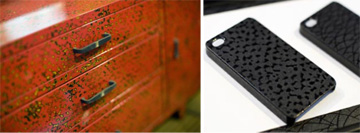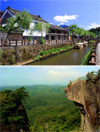Home > Highlighting JAPAN > Highlighting Japan FEBRUARY 2013 > Aomori/Chiba
Highlighting JAPAN
[SERIES] 47 PREFECTURES: FROM A TO Y
Aomori/Chiba
AOMORI—Cherry Blossoms and Lacquerware
Rob Gilhooly visits the castle town of Hirosaki and its neighboring municipality Tsugaru, in Aomori Prefecture.

Hirosaki Castle in the spring, surrounded by cherry blossoms
Credit: COURTESY OF HIROSAKI CITY OFFICE
There’s not another soul in sight, making it even harder to envisage Gen Horiuchi’s account of what it will look like here come late April. Then, says tree surgeon Horiuchi the 50-hectare park will be shrouded not in white, but in numerous shades of pink, teeming with pilgrims paying homage to one of Japan’s most instantly recognizable symbols.
There are more than 2,600 sakura cherry trees of approximately 70 varieties in the grounds of Hirosaki Castle and its botanical garden, among them Japan’s largest Somei-Yoshino tree. Records show one of the 2,600 sakura cherry trees to have been among 1,000 Somei-Yoshino cherries planted in the grounds 130 years ago by a former samurai, making it the oldest Somei-Yoshino in Japan.
Some sakura here are even older. A number of Shotokuzakura trees in the castle’s Ni-no-Maru district and other areas of the park date back three centuries. “In 1715, a samurai brought the saplings of twenty-five sakura trees from Kyoto to amuse the Daimyo, who was one of the most sophisticated people of his day,” Horiuchi says, adding that in 2011, the castle, which was once home to the Daimyo Tsugaru, celebrated its 400th anniversary.
Today these are hundreds more sakura give pleasure to considerably more than just a jolly vassal of the Shogun. Each cherry blossom season, an estimated 2 million visitors or more amble along the windy castle lanes, or enjoy boating beneath the blossoms in the sakura-lined Nishi-bori (west moat). Lining both sides of the lane on the castle side of the moat is possibly the most spectacular sakura “tunnel” in Japan.
At about the time that those first sakura trees were being planted in Hirosaki’s castle grounds, the city also welcomed its most unique and celebrated craft. Tsugaru-nuri lacquerware was brought to the city in the early 1700s by Ikeda Gentaro, who, following his father’s wishes, had gone to study lacquerware making in the nation’s capital, Edo, present-day Tokyo.

Exquisite Tsugaru lacquerware dressing table (left) and smartphone covers
Credit: ROB GILHOOLY
Over subsequent years the industry flourished, incorporating innovative styles that for their painstaking production techniques became known as “bakanuri,” or fool’s lacquer.
The degree to which the industry took off is reflected in documents held at the museum, which show there were once more than 500 different designs practiced by artisans. “Tsugaru is now one of the lacquerware production places attracting the most attention in Japan,” says Munakata.
Today there are approximately thirty artisans in Hirosaki who are working on reviving and reproducing the old techniques and designs. The number of techniques they practice have been narrowed down to four, according to Munakata. Perhaps the best-known of those is kara-nuri, a marble-like finish achieved through repeated painting and filing of dozens of layers of different colored lacquer.
While the styles practiced have decreased, the variety of items being decorated has grown. At Masato Kimura’s atelier in Hirosaki, smart phone covers and computer mouses are among more traditional items such as chopsticks may be found in the special drying rooms for lacquer. They are part of a local initiative to spread the appeal of the craft and ensure its continuation by offering training to young people.
“Until that started in recent years more than half of the craftsmen were over 65, and I was the youngest practitioner,” says Kimura, 47, who started helping the family business when still a toddler. “Now we have young apprentices in their twenties who are coming up with fresh ideas.”
Through the Tsugaru Urushi Spirit business collaboration, Kimura and three other local craftsmen have also been looking to introduce their products overseas, participating in exhibitions in Germany, Italy, France and the United States, among others.
“It might seem strange to look outside Japan when Tsugaru-nuri is not so well recognized even in western Japan,” says Tsugaru Urushi Spirit representative Teruyoshi Kon as he demonstrates the kara-nuri technique. “But through the attention given to our work overseas, there has been a renewal of interest in Japan.”
|
Aomori Facts Aomori is located at the northern end of the main island of Honshu. It is one of Japan’s leading agricultural prefectures. Suited to the features of the land and climate, rice and apples are grown mainly in the western section of the prefecture, while vegetable cultivation and livestock farming thrive in the southeastern section. Population: Approx. 1.37 million Area: Approx. 9,644 km2 Prefectural Capital: Aomori City Best in Japan: Apple and garlic harvests |
CHIBA—Boshu Uchiwa
Production of Boshu uchiwa fans is a beautiful but rapidly disappearing craft, as Rob Gilhooly discovered on his visit to one workshop in Minamiboso, Chiba Prefecture.

Masao Uyama at work on a bamboo fan; (top left) finished fans
Credit: ROB GILHOOLY
He then casts his expert eye over his creation before hanging it up to dry—the final step in a process he has employed for sixty-three years.
Uyama, 81, has been producing Boshu uchiwa fans since he was a teenager and a time when the ornate, non-folding fans were produced in the millions. Today, however, he is one of just five craftspeople making the fans and the only one executing the entire production process by himself.
That painstaking process incorporates twenty-one unique stages, from cutting down, stripping and splitting the bamboo to adorning the frames with a range of designs printed on high-quality washi paper and ornate textiles.
“There was a time when the fans were widely used to make fires and shoo away insects, but today they are mostly for decorative purposes,” says Uyama. “Many things have changed, but the production process remains the same.”
Boshu uchiwa are thought to have originated in Edo, present-day Tokyo, over 200 years ago. Also known as “Edo uchiwa,” the fans gained widespread popularity during the late Edo period (1603–1867), when wholesalers in the Nihonbashi district of the capital prospered.
The fans are traditionally made from me-dake bamboo, a variety known for its shortage of knots and superior flexibility. It is also a type that is readily found in Boshu (better known as Awa), the southern part of the Boso Peninsula in modern-day Chiba Prefecture. By the 1870s the area became a production hub, with more than 1,000 makers, mostly wives of famers and fishermen, producing the bamboo frames as a side business.
A turning point for the industry came after the 1923 Great Kanto Earthquake, which burned down the Nihonbashi wholesale district. Subsequently the entire production center was shifted to Chiba, from when the fans became exclusively known as “Boshu uchiwa.”
By the late-1920s around 8 million Boshu fans were being produced there each year and along with Marugame uchiwa from Shikoku and Kyoto’s Miyako fans they became known as one of Japan’s three most prestigious fans.
Boshu uchiwa are characterized by their cylindrical handles and an exposed portion of the 48- or 64-pronged rake-like frame known as the “window” that exhibits the artisan’s cutting skills.
According to Uyama, when he started out there were around thirty ateliers operating in his small village alone, but Japan’s economic expansion in the 1960s virtually wiped out the industry. “The spread of electric fans and air conditioners forced craftsmen to close down and start new businesses,” he says. “I thought about taking that route as well, but the money well had dried up.”
Although there was a surge in demand following the March 2011 disasters in Japan’s northeast, when an electricity shortage led people to look to alternative ways to stay cool in the humid summer months, production has since fallen to around 150,000, Uyama says, adding that many use frames mass-produced outside Japan.
The traditional crafting process employed by Uyama restricts output to just four or five fans a day.
“Air conditioners are an integral part of society now, but bamboo is an important part of our culture,” says Uyama, who was awarded Japan’s Order of the Sacred Treasure in 2011. “I hope people will be able to enjoy bamboo crafts such as this for many years to come.”
|
Chiba Facts Chiba Prefecture is located to the east of Tokyo, forming a peninsula that juts into the Pacific Ocean. The Minami-Boso area in the southern section of the prefecture is blessed with a temperate marine climate that stays somewhat warm in winter and somewhat cool in summer. At a popular site called the Flower Line, seasonal flowers adorn the sides of the prefectural road Population: Approx. 6.21 million Area: Approx. 5,156 km2 Prefectural Capital: Chiba City Best in Japan: Soy sauce production  Sawara townscape: The townscape of Sawara is referred to as the Hokuso region’s “little Edo.” Wooden townhouses, old-fashioned plaster warehouses and many other traditional buildings remain. Mt. Nokogiri: Mt. Nokogiri is one of the top three peaks in Chiba Prefecture. The name derives from its resemblance to a saw (nokogiri) blade. On the grounds of the Nihon Temple on the mountain is a stone Buddha statue measuring 31.05 m high, one of the largest in Japan. |
© 2009 Cabinet Office, Government of Japan






